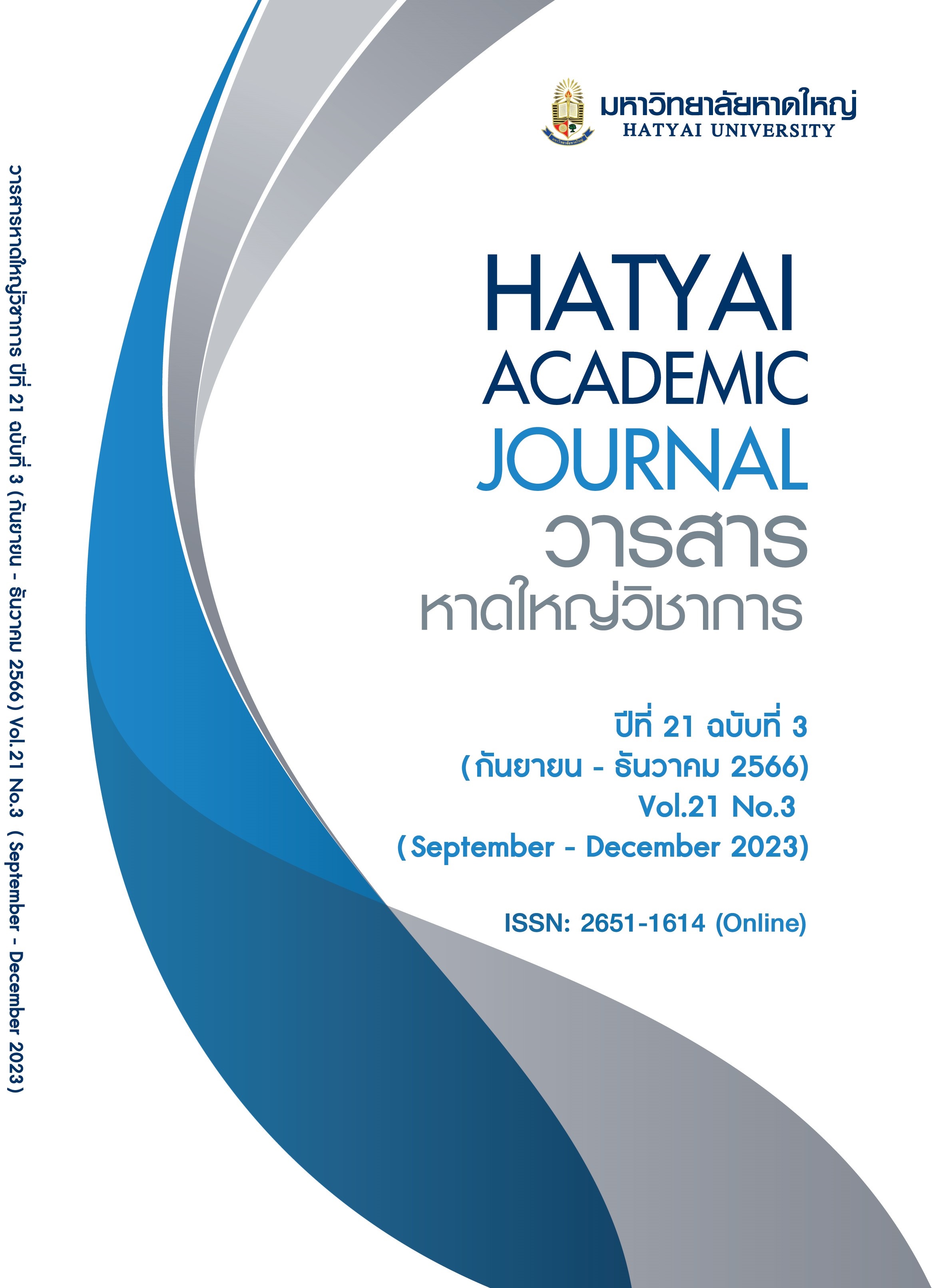Beliefs and Rituals Related to Animism and the Social Role of Thai Buddhists in Thung Yai District, Nakhon Si Thammarat Province
Main Article Content
Abstract
The objectives of this research were to 1) study the beliefs and rituals associated with spirit worship among Thai Buddhists in Thung Yai District, Nakhon Si Thammarat Province, and 2) study the social role of Thai Buddhists’ beliefs and rituals related to the worship of spirits in Thung Yai District. A qualitative research methodology was used in this study, along with cultural concepts such as the human code of thought, Structural Functionalism, and Functionalism. The researcher chose the Prik Subdistrict in Nakhon Si Thammarat Province as the research area. The purposive sampling method was chosen because it was in an area with a large Buddhist population. Data were collected from target groups aged 50 and higher. The sample group included expertise cohorts, practitioners, and related groups. An observation form, an interview form, and a camera were used as research instruments. The researcher gathered field data through interviews, group discussions, and observation, in addition to studying the documented information and presenting the research findings using the descriptive analysis method.
The study revealed:
1. The people in our study believe in spirits and believe that there are 30 different types of ghosts. These ghosts are classified into three categories: good ghosts, semi-good ghosts, and bad ghosts.
2. Three types of rituals worshipping ghosts by the the subjects were occupation rituals, life rituals, and miscellaneous rituals.
3. The social role of beliefs and rituals related to spirit worship of the subjects appeared in all seven positions; namely, the role of natural resources preservation, professions, health care, motivation, individual empowerment, gambling, and the responsibility of married life and one’s household.
Article Details

This work is licensed under a Creative Commons Attribution-NonCommercial-NoDerivatives 4.0 International License.
All published articles are evaluated by three qualified peer reviewers from various institutions through a double-blind process, where reviewers do not know the authors’ identities and authors do not know the reviewers’ identities. The content and articles in the Hatyai Academic Journal reflect the authors’ views only and are neither the opinions of the editorial board nor the responsibility of Hatyai University. The Editorial Board of the Hatyai Academic Journal allows articles to be reproduced for academic purposes, on the condition that the original source is clearly cited.
References
Boonkham, P. (2022, April 4). Nora lineage (interview). [in Thai]
Boonkham, S. (2022, March 30). Nora lineage (interview). [in Thai]
Burasit, Y., Pornsiripongse, S., & Sasiwongsaroj, K. (2015). “Phi-Pob” (ogre): A remaining discourse in digital age. Journal of Language and Culture, 34(2), 93-109. [in Thai]
Bussararat, P. (1996). Nora legends: Cultural and social relationship system of Songkhla Lake Basin. Songkhla: Thaksin Institute of Education, Thaksin University. [in Thai]
Chaisawat, N. (2019). Beliefs about ancestral spirits of southern Thai people: Ghosts, beavis and angels. Journal of Wiwittawansan, 3(2), 81-97. [in Thai]
Chamnankit, B. (2022, April 1). Nang Kwak lineage (interview). [in Thai]
Chuenka, R. (2021). Significance and ritual functions of ramakien characters worship in Bang Pla Community, Amphoe Bang Phli, Samut Prakan Province. Journal of Liberal Arts, Maejo University, 9(2), 121-142. [in Thai]
Ganjanapan, A. (2001a). Community dimension: Local ray of thinking about rights, powers and resource management. Bangkok: Chulalongkorn University. [in Thai]
Ganjanapan, A. (2001b). Complex thinking in community research: Dynamics and potential of communities in development. Bangkok: Research Fund Office. [in Thai]
Hongthong, A. (2022, March 9). Nora lineage (interview). [in Thai]
Intongkong, S. (1999). Chern Nang Mai. In The Encyclopedia of Central Thai Culture Volume 5 (pp. 2172-2173). Bangkok: Thailand Cultural Foundation encyclopedia Commercial Bank of Thailand. [in Thai]
Jarernpanit, T. (2016). Ghosts and power: Through ghosts believing of Thai Song Dum, Tambon Pun Sao, Bang Ra Gum, Phitsanulok. Journal of Ratchaphruek, 14(2), 67-74. [in Thai]
Kasem, P. (2009). Value of southern wisdom in the Sat Duan Sip. Nakhon Si Thammarat: San Nakhon Si Thammarat. [in Thai]
Meethaisong, T. (2011). Ghost and Buddhism, a blend of beliefs. Bangkok: Inthanin. [in Thai]
Nangkasem, N. (2015). Belief in the Pu Ta ghost in the Northeastern region: A case study of Ban Khon Buri, Khon Buri tai Subdistrict, Khon Buri District, Nakhon Ratchasima. Journal of Humanities, Ramkhamhaeng University, 4(1), 88-98. [in Thai]
Nankhantee, A. (2018). The dynamics of ghost worship of the Ban Noen Sa-at Lao ethnic group in the context of modern societ. Journal of Nakhon Phanom University, 8(2), 97-106. [in Thai]
Na Thalang, S. (2014). Folklore theory: Scientific methods for the analysis of myths–folktales. Bangkok: Chulalongkorn University. [in Thai]
Nitjaran, N. (2007). Nora: Symbols, rituals, Southern Thai indentity around Songkhla Lake in the globalization era (Master’s thesis). Chulalongkorn University, Bangkok [in Thai]
Phayomyong, M. (1985). Beliefs of Thai people in culture: Beliefs. Bangkok: Chulalongkorn University. [in Thai]
Phet-Awut, J. (2022, April 29). Nora lineage (interview). [in Thai].
Phongpit, S. (1999). “Ghost”: Traces of Thai beliefs. Bangkok: Chulalongkorn University. [in Thai]
Phongsai, S. (2019). Mae Nui: Meaning, value and reflection of southern Thai women’s power. Journal of Inthanin Thaksinsan, 14(2), 9-37. [in Thai]
Phromkaew. P. (2001). Beliefs and rituals related to animism and social roles of Thai Buddhists in the south (Research report). Songkhla: Thaksin University. [in Thai]
Rakquest, P. (2022, March 29). Nora lineage (interview). [in Thai]
Rueangnarong, P. (2016). Wannakam lae pasa thin tai. Bangkok: Sathapornbooks. [in Thai]
Sakunasing, L. (2013). Khamchuea lae prapheni: Koet taengngan tai. Bangkok: Phrao. [in Thai]
Sanyawiwat, S. (2000). Sociological theory of creation, valuation and utilization. Bangkok: Chulalongkorn University. [in Thai]
Shengyang, W. (2013). Preliminary study on the spread of Thai Kumanthong belief. Journal of Ramkhamhaeng, 33(2), 117-133. [in Thai]
Thongtao, P. (2020). The Roles of beliefs about the spirit to Isan society: A case study of Ubon Ratchathani. Journal of Liberal Art, Rang Sit University, 15(2), 221-236. [in Thai]

